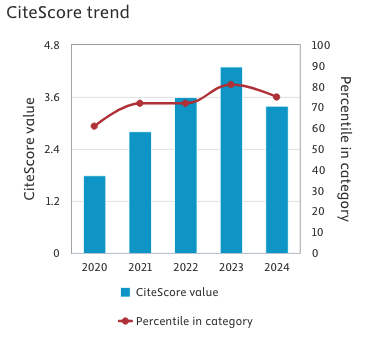Proximal humerus fractures in COVID-19 lockdown: the experience of three orthopedics and traumatology departments in the first ten weeks of the Italian epidemic
Keywords:
CoVID-19, proximal humerus fractures, Italian epidemic, Italian lockdownAbstract
Introduction: Coronavirus disease (CoVID-19) is causing millions of deaths worldwide and the crisis of the global healthcare system.
Aim Of The Study: evaluate the preliminary impact of CoVID-19 in three Italian Orthopedics and Traumatology Departments in the first 10 weeks of the national lockdown. We focused on proximal humerus fractures, analyzing data and results in comparison with the same period of 2019.
Materials And Methods: From February 22nd to May 3rd 2020, 55 patients were admitted to our departments for promixal humerus fractures. Our cohort of patients is composed by 13 males (23.6%) and 42 females (76.4%), with an average age of 73.8 ± 11.7 years (range 44 - 94). Trauma occurred at home in 43 cases (78.2%), by the roadside in 10 cases (18.2%), in a retirement home in 1 case (1.8%), and at work in 1 case (1.8%). We proposed surgical treatment in 15/55 cases, but 4 patients refused hospitalization, mainly because of the risk of contracting n-CoV19 infection.
Results: We noticed a decrease in proximal humerus fractures compared to 2019 (-37.5%). Particularly, we observed a significant drop in traumas occurred on the road and at work respectively 23.9% and 3.4%% in 2019, and 18.2% and 1.8% in 2020, probably due to the consequences of the national lockdown. Sports traumas had a reset during the pandemic (6 cases in 2019, 0 in 2020). As consequence, surgical treatment had a decrease due to the reduction in number of fractures, indications and patient’s consent.
Conclusion: The incidence of proximal humerus fractures had a significant reduction during CoVID-19 spread. We assume that the reasons of this reduction are to be found in the national lockdown (since March 10th, 2020) and Ministerial Decrees that limited the access to the E.R. only in case of severe traumas in order to avoid CoVID-19 spread.
References
Lu H, Stratton CW et al. (2020) Outbreak of pneumonia of unknown etiology in Wuhan, China: The mystery and the miracle. J Med Virol. 92(4):401-402. doi: 10.1002/jmv.25678
Lai CC, Shih TP, Ko WC, Tang HJ, Hsueh PR (2020) Severe acute respiratory syndrome coronavirus 2 (SARS-CoV-2) and coronavirus disease-2019 (COVID-19): The epidemic and the challenges. Int J Antimicrob Agents. 55(3):105924. doi: 10.1016/j.ijantimicag.2020.105924
Carlos WG, Dela Cruz CS, Cao B, Pasnick S, Jamil S. (2020) Novel Wuhan (2019-nCoV) Coronavirus. Am J Respir Crit Care Med. 201(4):7-8. doi: 10.1164/rccm.2014P7
Guan WJ, Ni ZY, Hu Y, et al. (2020). Clinical Characteristics of Coronavirus Disease 2019 in China. N Engl J Med. 382(18):1708-1720. doi: 10.1056/NEJMoa2002032
Giacomelli A, Pezzati L, Conti F et al. (2020) Self-reported Olfactory and Taste Disorders in Patients With Severe Acute Respiratory Coronavirus 2 Infection: A Cross-sectional Study. Clinical Infectious Diseases, 71(15):889–890, doi:10.1093/cid/ciaa330
Jin X, Lian JS, Hu JH, Gao J, Zheng L et al. (2020) Epidemiological, clinical and virological characteristics of 74 cases of coronavirus-infected disease 2019 (COVID-19) with gastrointestinal symptoms. 69(6):1002-1009. doi: 10.1136/gutjnl-2020-320926
Poggiali E, Ramos PM, Bastoni D, Vercelli A, Magnacavallo A. (2020) Abdominal Pain: A Real Challenge in Novel COVID-19 Infection. EJCRIM;7 doi:10.12890/2020_001632
Carinci F. (2020) Covid-19: preparedness, decentralisation, and the hunt for patient zero BMJ 368:bmj.m799 doi:10.1136/bmj.m799
Maniscalco P, Poggiali E, Quattrini F, et al. (2020) The deep impact of novel CoVID-19 infection in an Orthopedics and Traumatology Department: the experience of the Piacenza Hospital. Acta Biomed 91(2):97-105 https://doi.org/10.23750/abm.v91i2.9635
Bégué T. Articular fractures of the distal humerus. (2014) Orthop Traumatol Surg Res.100(1):55-63. doi:10.1016/j.otsr.2013.11.002
Caforio M, Maniscalco P, Colombo M, Calori GM. (2016) Long endomedullary nail in proximal third humeral shaft fractures. Injury. 47(4):64-70. doi:10.1016/j.injury.2016.07.037
Neer CS 2nd. (1970). Displaced proximal humeral fractures. I. Classification and evaluation. J Bone Joint Surg Am. 52(6):1077-89. PMID: 5455339
Benazzo F, Rossi SMP, Maniscalco P. et al. (2020) The orthopaedic and traumatology scenario during Covid-19 outbreak in Italy: chronicles of a silent war. International Orthopaedics (SICOT) 44,1453–1459 https://doi.org/10.1007/s00264-020-04637-3
Maniscalco P, Ciatti C, Gattoni S. The impact of covid-19 pandemic on the emergency room and orthopedic departments in piacenza: a retrospective analysis. Acta Biomed 2020; Vol. 91, S.14: e2020028. DOI: 10.23750/abm.v91i14-S.11003
Scarpioni R, Manini A, Valsania T, De Amicis S, Albertazzi V, Melfa L, Ricardi M, Rocca C. (2020) Covid-19 and its impact on nephropathic patients: the experience at Ospedale "Guglielmo da Saliceto" in Piacenza. G Ital Nefrol. 9;37(2):2020-vol2 PMID: 32281756
Huang C, Wang Y, Li X, et al. (2020). Clinical features of patients infected with 2019 novel coronavirus in Wuhan, China. Lancet. 395:497. https://doi.org/10.1016/S0140-6736(20)30183-5
Maniscalco P, Poggiali E, Quattrini F, et al. (2020) Proximal femur fractures in COVID-19 emergency: the experience of two Orthopedics and Traumatology Departments in the first eight weeks of the Italian epidemic. Acta Biomed. 91(2):89-96 https://doi.org/10.23750/abm.v91i2.9636
Maniscalco P, Quattrini F, Ciatti C et al. The Italian Covid-19 Phase 2 in Piacenza: results of the first semester of 2020 and future prospective of new orthopedics surgical procedures. Acta Biomed 2020; Vol. 91, N. 4: e2020159. DOI: 10.23750/abm.v91i4.10377

Downloads
Published
Issue
Section
License
This is an Open Access article distributed under the terms of the Creative Commons Attribution License (https://creativecommons.org/licenses/by-nc/4.0) which permits unrestricted use, distribution, and reproduction in any medium, provided the original work is properly cited.
Transfer of Copyright and Permission to Reproduce Parts of Published Papers.
Authors retain the copyright for their published work. No formal permission will be required to reproduce parts (tables or illustrations) of published papers, provided the source is quoted appropriately and reproduction has no commercial intent. Reproductions with commercial intent will require written permission and payment of royalties.






